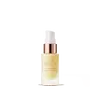What's inside
What's inside
 Key Ingredients
Key Ingredients

 Benefits
Benefits

 Concerns
Concerns

No concerns
 Ingredients Side-by-side
Ingredients Side-by-side

Water
Skin ConditioningArgania Spinosa Kernel Oil
EmollientGlycerin
HumectantNiacinamide
SmoothingPolyglyceryl-10 Oleate
Skin ConditioningCaprylic/Capric Triglyceride
MaskingKojic Acid
AntioxidantCoconut Alkanes
EmollientCandelilla/Jojoba/Rice Bran Polyglyceryl-3 Esters
EmulsifyingPropanediol
SolventAnanas Sativus Fruit Extract
Skin ConditioningPterocarpus Marsupium Bark Extract
Lactobacillus Ferment
Skin ConditioningTocopherol
AntioxidantOctadecenedioic Acid
EmulsifyingCitric Acid
BufferingLactic Acid
BufferingPhosphatidylglycerol
Pentylene Glycol
Skin ConditioningSorbitan Stearate
EmulsifyingSodium Stearoyl Lactylate
EmulsifyingGlyceryl Undecylenate
EmollientCetearyl Alcohol
EmollientGlyceryl Stearate
EmollientCetyl Palmitate
EmollientCoco-Caprylate/Caprate
EmollientSaccharide Isomerate
HumectantXanthan Gum
EmulsifyingSorbitan Palmitate
EmulsifyingGlyceryl Caprylate
EmollientSorbitan Oleate
EmulsifyingSodium Hydroxide
BufferingSodium Citrate
BufferingSodium Carbonate
BufferingSodium Chloride
MaskingTetrasodium Glutamate Diacetate
Cellulose Gum
Emulsion StabilisingPhenethyl Alcohol
MaskingSodium Benzoate
MaskingWater, Argania Spinosa Kernel Oil, Glycerin, Niacinamide, Polyglyceryl-10 Oleate, Caprylic/Capric Triglyceride, Kojic Acid, Coconut Alkanes, Candelilla/Jojoba/Rice Bran Polyglyceryl-3 Esters, Propanediol, Ananas Sativus Fruit Extract, Pterocarpus Marsupium Bark Extract, Lactobacillus Ferment, Tocopherol, Octadecenedioic Acid, Citric Acid, Lactic Acid, Phosphatidylglycerol, Pentylene Glycol, Sorbitan Stearate, Sodium Stearoyl Lactylate, Glyceryl Undecylenate, Cetearyl Alcohol, Glyceryl Stearate, Cetyl Palmitate, Coco-Caprylate/Caprate, Saccharide Isomerate, Xanthan Gum, Sorbitan Palmitate, Glyceryl Caprylate, Sorbitan Oleate, Sodium Hydroxide, Sodium Citrate, Sodium Carbonate, Sodium Chloride, Tetrasodium Glutamate Diacetate, Cellulose Gum, Phenethyl Alcohol, Sodium Benzoate
Water
Skin ConditioningIsopentyldiol
HumectantGlycerin
Humectant1,2-Hexanediol
Skin ConditioningButylene Glycol
HumectantBetaine
HumectantHydroxyethylcellulose
Emulsion StabilisingAscorbic Acid
AntioxidantSodium Citrate
BufferingTromethamine
BufferingEthylhexylglycerin
Skin ConditioningDipotassium Glycyrrhizate
HumectantPropanediol
SolventPolyglyceryl-10 Laurate
Skin ConditioningDisodium EDTA
Sodium Hyaluronate
HumectantHippophae Rhamnoides Fruit Extract
Skin ConditioningBeta-Glucan
Skin ConditioningAscorbyl Glucoside
AntioxidantWater, Isopentyldiol, Glycerin, 1,2-Hexanediol, Butylene Glycol, Betaine, Hydroxyethylcellulose, Ascorbic Acid, Sodium Citrate, Tromethamine, Ethylhexylglycerin, Dipotassium Glycyrrhizate, Propanediol, Polyglyceryl-10 Laurate, Disodium EDTA, Sodium Hyaluronate, Hippophae Rhamnoides Fruit Extract, Beta-Glucan, Ascorbyl Glucoside
Ingredients Explained
These ingredients are found in both products.
Ingredients higher up in an ingredient list are typically present in a larger amount.
Glycerin is already naturally found in your skin. It helps moisturize and protect your skin.
A study from 2016 found glycerin to be more effective as a humectant than AHAs and hyaluronic acid.
As a humectant, it helps the skin stay hydrated by pulling moisture to your skin. The low molecular weight of glycerin allows it to pull moisture into the deeper layers of your skin.
Hydrated skin improves your skin barrier; Your skin barrier helps protect against irritants and bacteria.
Glycerin has also been found to have antimicrobial and antiviral properties. Due to these properties, glycerin is often used in wound and burn treatments.
In cosmetics, glycerin is usually derived from plants such as soybean or palm. However, it can also be sourced from animals, such as tallow or animal fat.
This ingredient is organic, colorless, odorless, and non-toxic.
Glycerin is the name for this ingredient in American English. British English uses Glycerol/Glycerine.
Learn more about GlycerinPropanediol is an all-star ingredient. It softens, hydrates, and smooths the skin.
It’s often used to:
Propanediol is not likely to cause sensitivity and considered safe to use. It is derived from corn or petroleum with a clear color and no scent.
Learn more about PropanediolSodium Citrate is the sodium salts of citric acid. In skincare, it is used to alter pH levels and acts as a preservative.
Its main functions are to maintain the pH of a product and neutralize metal ions.
The acidity of our skin is maintained by our glands and skin biome; normal pH level of skin is slightly acidic (~4.75-5.5).
Being slightly acidic allows our skin to create an "acid mantle". This acid mantle is a thin barrier that protects our skin from bacteria and contaminants.
Learn more about Sodium CitrateWater. It's the most common cosmetic ingredient of all. You'll usually see it at the top of ingredient lists, meaning that it makes up the largest part of the product.
So why is it so popular? Water most often acts as a solvent - this means that it helps dissolve other ingredients into the formulation.
You'll also recognize water as that liquid we all need to stay alive. If you see this, drink a glass of water. Stay hydrated!
Learn more about Water